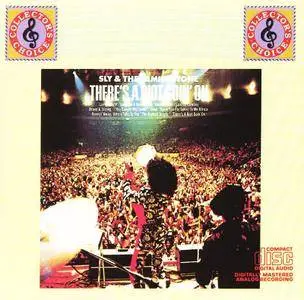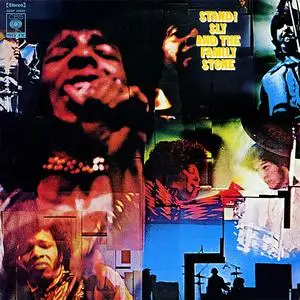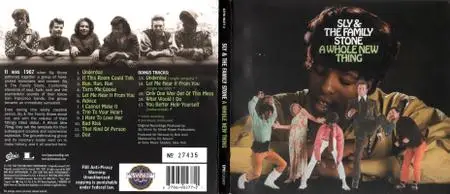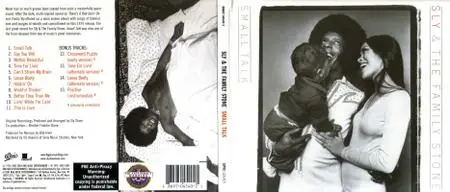Sly+&+the+family+stone
Rockpalast: From The Archives - Neil Young (1971) and Sly & The Family Stone (1970) [2013, HDTV 720p] Music
Posted by v3122 at April 29, 2014
Rockpalast: From The Archives - Neil Young (1971) and Sly & The Family Stone (1970)
TS, 1280x720 16:9, 50fps, 5566kbps | MPEG Audio, 2ch, 192kbps
Rock / Folk Rock / Psychedelic Soul | 02:19:00 | ~ 6.24 Gb
~ Neil Young: 23.04.1971 and 14.05.1971, Sly & The Family Stone: 10.12.1970 ~
TS, 1280x720 16:9, 50fps, 5566kbps | MPEG Audio, 2ch, 192kbps
Rock / Folk Rock / Psychedelic Soul | 02:19:00 | ~ 6.24 Gb
~ Neil Young: 23.04.1971 and 14.05.1971, Sly & The Family Stone: 10.12.1970 ~
Sly & The Family Stone - Anthology (1981) Music
Posted by v3122 at June 15, 2021
Sly & The Family Stone - Anthology (1981)
EAC | Flac(Image) + Cue + Log & MP3 CBR 320Kbps
1989 | Epic, EGK 37071 | ~ 442 or 177 Mb | Scans
Funk / Soul
EAC | Flac(Image) + Cue + Log & MP3 CBR 320Kbps
1989 | Epic, EGK 37071 | ~ 442 or 177 Mb | Scans
Funk / Soul
Anthology essentially replicates the previous collection Greatest Hits and adds singles from There's a Riot Goin' On and Fresh to the end of the album. Where Greatest Hits didn't follow chronological order, Anthology presents every single in the order it was released – and, with the exception of the latter-day singles and the inclusion of "Don't Call Me Nigger, Whitey," that is the major difference between the two collections…
Sly & The Family Stone - There's A Riot Goin' On (1971) [2013, Get On Down/Epic, GET 9009 CD/88765404332] Re-up Music
Posted by v3122 at Aug. 11, 2021
Sly & The Family Stone - There's A Riot Goin' On (1971)
EAC | Flac(Image) + Cue + Log & MP3 CBR 320Kbps
Get On Down/Epic, GET 9009 CD/88765404332 | ~ 296 or 113 Mb | Scans(jpg) -> 5.44 Mb
Funk / Soul / R&B
EAC | Flac(Image) + Cue + Log & MP3 CBR 320Kbps
Get On Down/Epic, GET 9009 CD/88765404332 | ~ 296 or 113 Mb | Scans(jpg) -> 5.44 Mb
Funk / Soul / R&B
It's easy to write off There's a Riot Goin' On as one of two things – Sly Stone's disgusted social commentary or the beginning of his slow descent into addiction. It's both of these things, of course, but pigeonholing it as either winds up dismissing the album as a whole, since it is so bloody hard to categorize. What's certain is that Riot is unlike any of Sly & the Family Stone's other albums, stripped of the effervescence that flowed through even such politically aware records as Stand! This is idealism soured, as hope is slowly replaced by cynicism, joy by skepticism, enthusiasm by weariness, sex by pornography, thrills by narcotics…
Sly & The Family Stone - There's A Riot Goin' On (1971) Re-up Music
Posted by v3122 at July 28, 2021
Sly & The Family Stone - There's A Riot Goin' On (1971)
EAC | Flac(Image) + Cue + Log & MP3 CBR 320Kbps
1990 | Epic, EK 30986 | ~ 265 or 114 Mb | Scans
Funk / Soul / Rock / R&B
EAC | Flac(Image) + Cue + Log & MP3 CBR 320Kbps
1990 | Epic, EK 30986 | ~ 265 or 114 Mb | Scans
Funk / Soul / Rock / R&B
It's easy to write off There's a Riot Goin' On as one of two things – Sly Stone's disgusted social commentary or the beginning of his slow descent into addiction. It's both of these things, of course, but pigeonholing it as either winds up dismissing the album as a whole, since it is so bloody hard to categorize…
Sly & the Family Stone - Stand! (1969) Music
Posted by v3122 at July 26, 2021
Sly & the Family Stone - Stand! (1969)
EAC | Flac(Image) + Cue + Log & MP3 CBR 320Kbps
2007 | Epic/Legacy, 82876 75912 2 | ~ 351 or 138 Mb | Artwork(jpg) -> 11 Mb
Funk / Soul | Remastered
EAC | Flac(Image) + Cue + Log & MP3 CBR 320Kbps
2007 | Epic/Legacy, 82876 75912 2 | ~ 351 or 138 Mb | Artwork(jpg) -> 11 Mb
Funk / Soul | Remastered
Stand! is the pinnacle of Sly & the Family Stone's early work, a record that represents a culmination of the group's musical vision and accomplishment. Life hinted at this record's boundless enthusiasm and blurred stylistic boundaries, yet everything simply gels here, resulting in no separation between the astounding funk, effervescent irresistible melodies, psychedelicized guitars, and deep rhythms…
Sly & The Family Stone - Stand! (1969) Vinyl & HR
Posted by v3122 at June 24, 2022
Sly & The Family Stone - Stand! (1969))
Vinyl Rip | 24-bit/192 kHz | Flac(Tracks) > 1.53 Gb | Artwork > 207 Mb
CBS/Sony, SONP 50099 | Japan | Psychedelic, Funk, Soul
Vinyl Rip | 24-bit/192 kHz | Flac(Tracks) > 1.53 Gb | Artwork > 207 Mb
CBS/Sony, SONP 50099 | Japan | Psychedelic, Funk, Soul
Stand! is the pinnacle of Sly & the Family Stone's early work, a record that represents a culmination of the group's musical vision and accomplishment. Life hinted at this record's boundless enthusiasm and blurred stylistic boundaries, yet everything simply gels here, resulting in no separation between the astounding funk, effervescent irresistible melodies, psychedelicized guitars, and deep rhythms…
Sly & The Family Stone - Live At The Fillmore East 1968 (2015) [4CD Box Set] Music
Posted by v3122 at Nov. 24, 2019
Sly & The Family Stone - Live At The Fillmore East 1968 (2015)
EAC | Flac(Tracks) + Cue + Log & MP3 CBR 320Kbps
4CD | Epic/Legacy, 88843023712 | ~ 1286 or 476 Mb | Scans(jpg) -> 51 Mb
Funk / Soul / Rock / R&B
EAC | Flac(Tracks) + Cue + Log & MP3 CBR 320Kbps
4CD | Epic/Legacy, 88843023712 | ~ 1286 or 476 Mb | Scans(jpg) -> 51 Mb
Funk / Soul / Rock / R&B
When Sly & the Family Stone seized Manhattan's Fillmore East for a two-night, four-set stand in October 1968, the sonically and socially advanced band was just starting to cook. Earlier in the year, "Dance to the Music" became their first charting single, a Top 10 pop hit…
Sly & The Family Stone - A Whole New Thing (1967) Music
Posted by v3122 at July 14, 2021
Sly & The Family Stone - A Whole New Thing (1967)
EAC | Flac(Image) + Cue + Log & MP3 CBR 320Kbps
2007 | Epic/Legacy, 82796 90277 2 | ~ 318 or 134 Mb | Artwork(jpg) -> 6.96 Mb
Funk / Soul
EAC | Flac(Image) + Cue + Log & MP3 CBR 320Kbps
2007 | Epic/Legacy, 82796 90277 2 | ~ 318 or 134 Mb | Artwork(jpg) -> 6.96 Mb
Funk / Soul
Sly & the Family Stone's debut album is more restrained and not nearly as funky or psychedelic as their subsequent efforts, owing far more to traditional soul arrangements. These aren't that traditional, though; Sly is already using goofier and/or more thoughtful lyrics than the soul norm, and taking some cues from rock in his adventurous and unexpected song construction…
Sly & The Family Stone - There's A Riot Goin' On (1971) [2013, Get On Down/Epic, GET 9009 CD/88765404332] Music
Posted by v3122 at Sept. 3, 2018
Sly & The Family Stone - There's A Riot Goin' On (1971)
EAC | Flac(Image) + Cue + Log & MP3 CBR 320Kbps
Get On Down/Epic, GET 9009 CD/88765404332 | ~ 296 or 113 Mb | Scans(jpg) -> 5.44 Mb
Funk / Soul / R&B
EAC | Flac(Image) + Cue + Log & MP3 CBR 320Kbps
Get On Down/Epic, GET 9009 CD/88765404332 | ~ 296 or 113 Mb | Scans(jpg) -> 5.44 Mb
Funk / Soul / R&B
It's easy to write off There's a Riot Goin' On as one of two things – Sly Stone's disgusted social commentary or the beginning of his slow descent into addiction. It's both of these things, of course, but pigeonholing it as either winds up dismissing the album as a whole, since it is so bloody hard to categorize. What's certain is that Riot is unlike any of Sly & the Family Stone's other albums, stripped of the effervescence that flowed through even such politically aware records as Stand! This is idealism soured, as hope is slowly replaced by cynicism, joy by skepticism, enthusiasm by weariness, sex by pornography, thrills by narcotics…
Sly & The Family Stone - Small Talk (1974) Music
Posted by v3122 at Jan. 11, 2020
Sly & The Family Stone - Small Talk (1974)
EAC | Flac(Image) + Cue + Log & MP3 CBR 320Kbps
2007 | Epic/Legacy, 88697 04540 2 | ~ 285 or 118 Mb | Artwork(jpg) -> 13 Mb
Funk / Soul
EAC | Flac(Image) + Cue + Log & MP3 CBR 320Kbps
2007 | Epic/Legacy, 88697 04540 2 | ~ 285 or 118 Mb | Artwork(jpg) -> 13 Mb
Funk / Soul
A new bass player and drummer signaled a toned-down Sly & the Family Stone sound. Partially in keeping with changes in much of popular music in the early '70s, and maybe the result of marriage and a child, Sly became more introspective, quieter, and calmer, even employing a string section on various cuts…
![Rockpalast: From The Archives - Neil Young (1971) and Sly & The Family Stone (1970) [2013, HDTV 720p]](https://pixhost.icu/avaxhome/05/82/002c8205_medium.jpeg)

![Sly & The Family Stone - There's A Riot Goin' On (1971) [2013, Get On Down/Epic, GET 9009 CD/88765404332] Re-up](https://pixhost.icu/avaxhome/6d/5c/005b5c6d_medium.jpg)



![Sly & The Family Stone - Live At The Fillmore East 1968 (2015) [4CD Box Set]](https://pixhost.icu/avaxhome/2a/bf/003fbf2a_medium.jpg)

